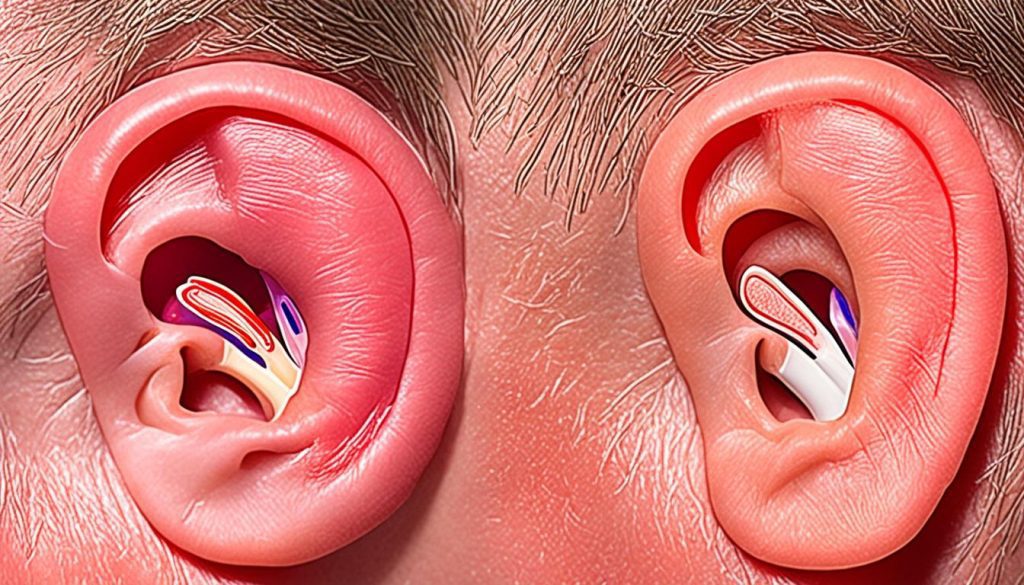Barotitis media, or ear barotrauma, is a result of uneven pressure on both sides of the eardrum. This often happens when you’re flying or diving because of the quick changes in external pressure. If you have barotitis media, you might feel pressure in your ear, pain, experience ringing, or even lose some hearing. Doctors can tell if you have it by looking into your history and checking your ear closely. They might suggest simple treatments like nasal sprays or more serious steps like surgery. Lately, using stem cells to treat barotitis media has gained attention. This new method works by helping your eustachian tube work better and easing your symptoms.
Key Takeaways:
- Barotitis media, also known as ear barotrauma, is caused by abnormal pressure differences on either side of the eardrum.
- Symptoms of barotitis media include ear pressure, ear pain, tinnitus, and hearing loss.
- Barotitis media can be diagnosed through patient history and physical examination of the ear.
- Treatment options include conservative management and surgical intervention, with stem cell therapy showing promise.
- Stem cell therapy for barotitis media aims to improve eustachian tube function and provide relief from symptoms.
Symptoms of Barotitis Media
Barotitis media, also known as ear barotrauma, comes with different symptoms for the ears. Knowing these symptoms is crucial. They can show if this condition is present.
- Ear Pressure: A main symptom of barotitis media is pressure in the ear. It feels like your ears are full or uncomfortable.
- Ear Pain: People with this condition might feel ear pain, or otalgia. Pain levels can be low or high.
- Hearing Loss: Sometimes, barotitis media might cause you to hear less well. This could happen in one or both ears, which is worrisome.
- Tinnitus: A frequent symptom of barotitis media is tinnitus. This means you hear ringing or buzzing sounds. They can come and go.
These symptoms could get worse with changes in altitude or pressure. If they affect your daily life, see a doctor for assessment and treatment.
Seeking Medical Attention
If you see signs of barotitis media, seeing a doctor is key. They will check you carefully and diagnose you correctly. Finding and treating it early can ease symptoms and stop further issues.
Causes of Barotitis Media
Barotitis media mainly happens when the eustachian tube doesn’t work right. This tube should balance the pressure in the middle ear with the air outside. Several things can mess up this function, such as:
- Allergies
- Immune function problems
- Sinusitis
- Gastroesophageal reflux
Other things like flying or diving can change pressure and cause barotitis media. There are also some less common causes to know about:
- Upper respiratory tract infections
- Nasopharyngeal carcinoma
- Barotrauma from blast injuries
To treat barotitis media well, you need to find out what’s causing it. Knowing the cause helps doctors make a plan. They aim to fix the pressure problem in the ear by treating the root cause.
Diagnosis of Barotitis Media
The diagnosis of barotitis media comes from the patient’s history, the symptoms they report, and an ear check. A healthcare provider might look inside the ear with otoscopy. This shows the eardrum and checks for swelling or fluid. They might also do a tympanogram to see how the middle ear works. A hearing test can find any hearing issues. These tests confirm barotitis media and help decide the best treatment.

| Diagnostic Method | Description |
|---|---|
| Otoscopy | Visualization of the eardrum to look for inflammation or fluid accumulation |
| Tympanogram | Evaluation of middle ear function and pressure changes |
| Hearing Examination | Assessment of hearing loss or abnormalities |
Otoscopy lets doctors see the eardrum directly. They check for swelling or fluid. This helps figure out if barotitis media is the problem. It also rules out other ear issues.
A tympanogram checks how the eardrum moves with air pressure changes. It shows if the middle ear is working right. A normal test means the pressure is fine. An abnormal test suggests problems, like those seen with barotitis media.
A hearing examination checks how well someone can hear. It spots any hearing loss or problems. Tests like pure-tone and speech audiometry measure hearing damage. This helps create a treatment plan for barotitis media.
To sum up, diagnosing barotitis media needs a look at medical history, symptoms, and specific tests. Tests like otoscopy, tympanogram, and hearing checks are crucial. They confirm if someone has barotitis media. This guides doctors in treating it correctly.
Stem Cell Therapy for Barotitis Media
Stem cell therapy is a new hope for treating barotitis media. These cells can repair and heal damaged ear tissues. This could help the eustachian tube work better.
Early studies are encouraging, showing fewer symptoms and better hearing. But, we need more research to be sure it’s effective and safe for barotitis media.
This approach could change how we treat barotitis media. It offers hope for lasting symptom relief and a better life. The future looks promising with ongoing research.
Advantages of Stem Cell Therapy for Barotitis Media:
- Potential for tissue regeneration and repair
- Improved eustachian tube function
- Reduced symptoms
- Improved hearing
Considerations for Stem Cell Therapy:
It’s key to be careful with stem cell therapy right now. We need more study on the right doses and how to safely give the treatment. It must pass strict standards to ensure it helps patients safely.
| Advantages of Stem Cell Therapy for Barotitis Media | Considerations for Stem Cell Therapy |
|---|---|
|
|
Conclusion
Barotitis media, also known as ear barotrauma, happens when pressure in the middle ear goes awry. You might feel ear pressure, pain, lose some hearing, or hear ringing. The main culprit behind this is eustachian tube dysfunction, influenced by many factors.
Figuring out if it’s barotitis media involves looking at your medical history and doing a physical exam. Doctors might also use tools like otoscopy and tympanogram for diagnosis. The treatment can be simple or involve surgery, depending on how severe it is.
There’s promising news in treating ear barotrauma with stem cell therapy. These cells could heal and fix the damaged ear parts. This could mean better eustachian tube function and relief from annoying symptoms. Although promising, this treatment needs more research to prove it’s safe and works well.
If your ears hurt, feel pressured, you’re losing hearing, or hear ringing, see a doctor. They will figure out if it’s barotitis media and decide on the best treatment. This will help ease your symptoms and make life more enjoyable.
FAQ
Q: What are the symptoms of Barotitis Media?
A: Symptoms include feeling pressure in your ear and pain. You may also hear ringing and could have temporary hearing loss.
Q: What causes Barotitis Media?
A: It’s mainly due to problems with the eustachian tube. Allergies, immune issues, and changes in altitude can affect it.
Q: How is Barotitis Media diagnosed?
A: Doctors look at your symptoms and check your ears. They might do an ear exam and hearing tests.
Q: What is stem cell therapy for Barotitis Media?
A: Stem cell therapy treats ear damage by injecting healing cells. It aims to fix the eustachian tube.
Q: How effective is stem cell therapy for Barotitis Media?
A: Early studies are hopeful, but more research is needed. We must prove it’s safe and works well.
Q: When should I seek medical attention for Barotitis Media symptoms?
A: See a doctor if you have symptoms, especially if they don’t go away or affect your day-to-day life.

